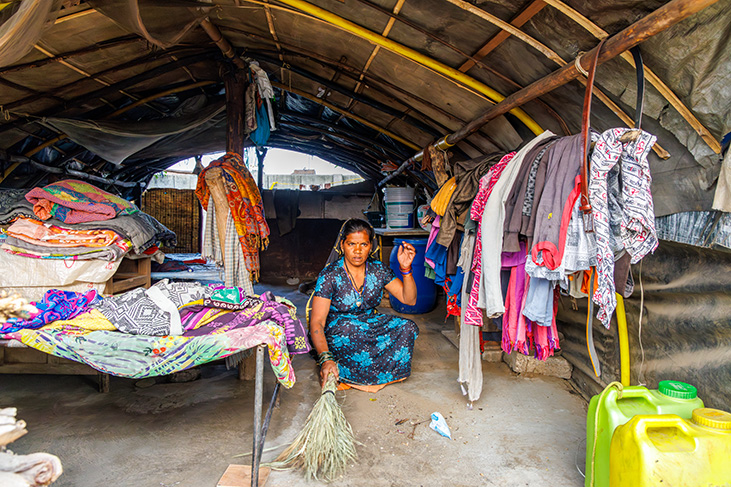


LAKHS OF LABOURERS NEED BASIC SOCIAL SECURITY LIKE ACCESS TO DRINKING WATER, MOBILE TOILETS, MOBILE SCHOOLS & SUBSIDIZED MEALS
Ramila , who hails from Jaisawada village in the tribal district of Dahod in Gujarat, has been coming to Ahmedabad city along with her husband for the last three years to work as a construction labourer. Her current project involves digging trenches for a local PNG company.
She stays in a cluster of shanties erected for laborers in a plot in Vastral by the contractor working for the gas company. Even as the contractor pays a Rs 30,000 rent to the plot owner, Ramila’s family as other labourer families must pay the contractor monthly rent of Rs 800 as rent for the tarpaulin shanties.
“We pay Rs 800 rent for the small and congested shanty. There is no light, no electricity, no drinking water supply and during heavy rains, the plot gets flooded with water. We have no option but to stay here,” says Ramila, who is mother to 14-year-old twin boys and a 15-year-old daughter. She has left her sons back home with her mother-in-law but her daughter who has dropped out from school has come to work with them. She has a mobile phone and pays Rs 10 daily to get it recharged at the local grocer shop.
RAMILA IS ONE OF MILLIONS OF MIGRANT CONSTRUCTION WORKERS WHO LEAVE HOME FOR CITIES
Ramila Bharsinhbhai is one of the millions of migrant construction workers in India who are forced to leave her home, hearth and children in villages and move to cities in search of better paying labour work at construction sites. With no social security schemes guarding the housing, health and education needs of her and her family, they toil hard in the day and live in small shanties without power and basic facilities like toilets.
BETTER WORK OPPORTUNITIES & INCOME LURE MIGRANT CONSTRUCTION LABOURERS TO CITIES
Ramila says she gets paid Rs 400 per day for digging 1 meter long and 4 to 5 feet deep trenches. She gets paid extra for over-time. Together, the family of three earns Rs 12,000 a month. During monsoons, the family largely sustains on maize flour brought from their village. Ramila says they get only Rs 200 per day for labour work in villages. The Mahatma Gandhi National Rural Employment Guarantee Act (MGNREGA) offers work but it is not guaranteed. Once the dedicated contract work for companies gets over, the migrant labourer families opt for contractual masonry work. The Kadia Naka crossroads at CTM mill area becomes Ramila’s next source of income.
MIGRANT CONSTRUCTION LABOURERS WORK LACKS BASIC AMENITIES OF HOUSING, HEALTH, EDUCATION & SAFETY.
URGENT WELFARE MEASURES ARE NEEDED BY WELFARE BOARD AND POLICY MAKERS!
SEWA leaders say that migrant construction workers are forced to come to cities looking for work. This segment forms a major component of the unorganized labour force in India giving employment to millions of workers.
“Majority of the migrant construction workers live in poor housing conditions, have no access to electricity, drinking water, anganwadis and schools and hospitals. Most of the families bring infants and toddlers with them but leave young children back home with elders. This leads to major disruptions in education and health and vaccination for these children,” said SEWA leaders.
The Building and Other Construction Workers Board reportedly has a corpus of Rs 78,000 crore of which only a fraction is spent while the rest of the giant funds lie unused. This, leaders say, should be effectively put to use for the welfare and benefit of lakhs of migrant construction workers.
SEWA LEADERS MAKE FOLLOWING SUGGESTIONS
All migrant construction workers should be registered and basic make-shift residential facilities including toilets be made available for them.
NGOs and other agencies can be roped in to set-up mobile toilets for spaces where migrant construction labourers have set up make-shift residences so that they get access to clean, hygienic toilets.
As majority of temporary residences for migrant workers, the government can make provision of subsidized solar lamps for the workers to ensure they have access to light during the night time.
Fabricated and movable structures can also be provided for the migrant workers to enhance the quality of housing made available for the workers.
Migrant construction workers should have `identity portability’ in the country which enables them to open bank accounts in cities using their ID cards with village addresses. This will help them get benefit of various government welfare schemes for the migrant workers which are credited straight into bank accounts.
Majority of construction workers leave their older children home while they bring their infants and toddlers to the city. Makeshift anganwadis should be set up near these localities so that the infants’ health can be monitored and toddlers can get access to nutritious mid-day meals to prevent malnourishment and disease.
Mobile school facilities can be arranged near such localities to ensure that while the labourers are at work, the children can be taught basic language and computing skills as well as provided reading and writing skills.
For every locality housing 50-100 migrant construction workers, an Annapurna meal scheme whereby cooked meals are made available to workers on a token amount of Rs 10 should be set up for access to nutritious, subsidized meals.
Registration of migrant workers in cities should be mandated to ascertain the influx of migrant labour in a particular city.